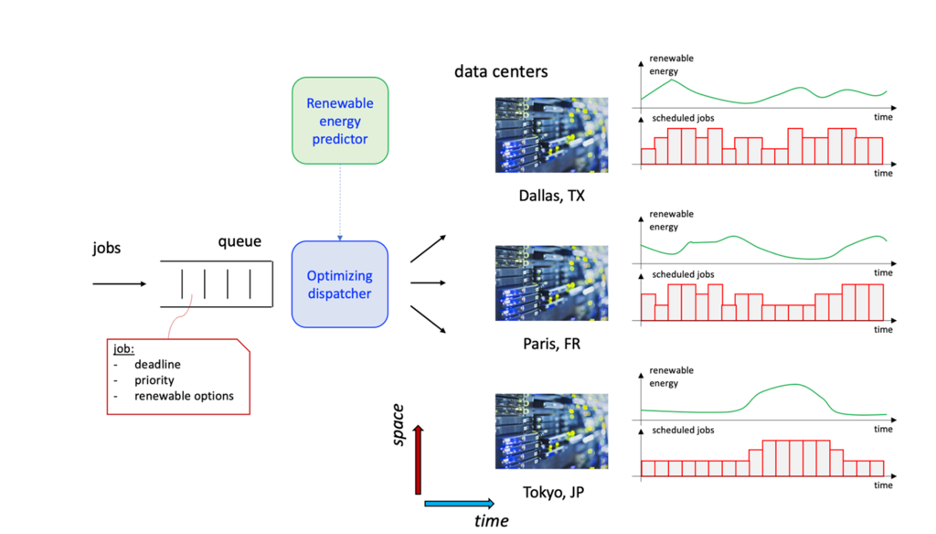Coauthor: Alaa Youssef –Manager, Container Cloud Platform (asyousse@us.ibm.com)
Given that earth day is every day and computing is increasingly ubiquitous, we should consider its environmental impact. Analysis built on industry-reported characterization, quantifies the environmental effects of computing in terms of carbon emissions. Broadly, carbon emissions have two sources: operational energy consumption, and hardware manufacturing and infrastructure. Although carbon emissions from the former are decreasing thanks to algorithmic, software, and hardware innovations that boost performance and power efficiency, the overall carbon footprint of computer systems continues to grow – some analysis show that most emissions related to modern mobile and data-center equipment come from hardware manufacturing and infrastructure.
The IT industry is becoming increasingly aware and socially responsible for their energy consumption. A data center's carbon footprint is seen as the new battleground for cloud providers (IDC) and CIOs are now leading the sustainability projects in more than 50% of companies. They are saving on carbon footprint by moving to the cloud and implementing AI to improve energy consumption efficiency. Some Cloud Providers took it a step further and are exploring underwater datacenters or datacenters located in cold regions to efficiently extract heat and reuse the energy.
Having said that, let’s look at areas to dynamically move or place workloads that take into account the energy characteristics of datacenters as the next level of optimization.
IBM Vision: Carbon Performance Hybrid Cloud
To build a sustainable hybrid cloud that can measure, visualize, and optimize carbon footprint at all levels in a heterogeneous environment, with multiple on-prem datacenters and public cloud providers; you must leverage an open hybrid cloud architecture like IBM Red Hat OpenShift simply because it’s designed to enable flexible, secure, and high performing computing for every workload. Also, data centers must be designed for low carbon emissions through intelligent dynamic cooling to reduce power usage, or heat extraction and other physical offsetting techniques. The vision is to leverage software-based carbon-aware controllers deployed at various levels of the data centers and across data centers to reduce carbon footprint. Controllers coordinate placement of VMs and containers to optimize utilization and to dispatch jobs across datacenters based on renewable energy.
Building a sustainable hybrid cloud is a journey that requires tools - quantification, transformation, and migration practices, to assist clients on their journey to a sustainable hybrid cloud. Analytics and AI algorithms can be used to examine carbon intensity and historical views of IT equipment energy to forecast the overall carbon footprint of a given datacenter at a given time in the future.
Optimizing Workload Dispatching Based on Green Energy
IBM has several software assets that are being adapted to address the challenge of managing workloads with energy awareness.
For optimizing workloads running in VMs and containers, Turbonomic offers a wealth of policies that make recommendation on rightsizing or moving components of an application within and between datacenters that can optimize power and energy efficiency.
Observability tools like Instana need to be extended to understand the carbon impact of workloads down to understanding the carbon footprint of various transactions.
IBM CloudPak for Watson AIOps takes an application-centric view of infrastructure providing AI-driven insights to IT operations staff to identify problems, their root causes, and recommended solutions without the need for human intervention. Energy and power consumption insights together with data from other sources will enable AIOps users to understand the carbon footprint of applications (IBM Cloud blog).
The IBM Environmental Intelligence Suite takes into account weather-related information to plan for and respond to critical weather events with advanced analytics to ensure business continuity. Such tools can incorporate energy and power consumption information to give a holistic view of the environment.
For high performance computing workloads that often run on bare metal servers in datacenters, Spectrum LSF offers energy aware scheduling capabilities.
If you are running batch workloads on Kubernetes, IBM Research has made available an open-source project Multi-cluster Application Dispatcher that can direct workloads across geographically distributed clusters. Work is underway to account for predictions of future carbon and workload intensity values in dispatching jobs such as machine or deep learning jobs that consume power-intensive GPU resources.

For long running services in Kubernetes, multiple deployments of the service can be made simultaneously to multiple data centers via Redhat Advanced Cluster Manager (ACM) placement rules. Service requests are routed to the deployment at the data center with lowest carbon intensity at the time of receiving the request. Coupled with horizontal scaling up/down of each of the service deployments, this leads to carbon footprint minimization besides efficient utilization of resources.